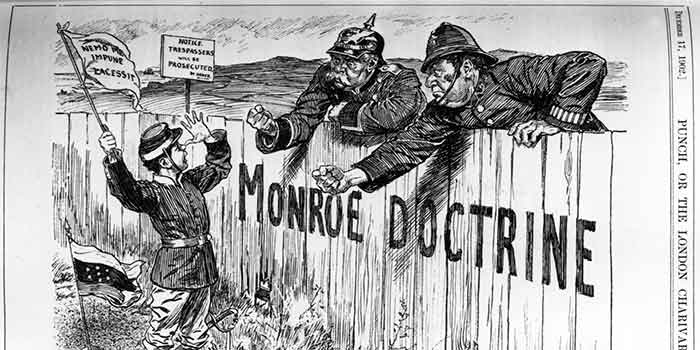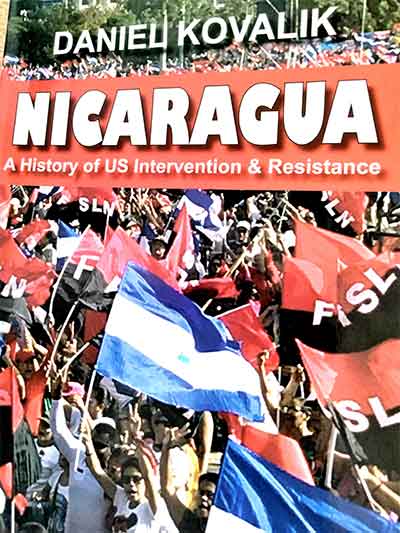
When those of us of a certain age were in school, we learned that the Monroe Doctrine committed the United States to protect the independence of Latin American nations, which had just freed themselves from Spanish and Portuguese rule. While it granted European nations the right to keep whatever colonies they still had in the Western Hemisphere, it declared that any attempt on Europe’s part to expand those colonies would be considered an unfriendly act against the United States. It looked like a brave and noble act, and a step forward for the U.S. on the world stage.
As the doctrine approaches its 200th anniversary December 2, we know it ain’t necessarily so.
At first, the U.S. couldn’t enforce it because its navy was too small to keep European powers out. However, the British navy was quite willing to do the job now that Latin markets were open to British trade. In that vein, British Foreign Secretary Lord George Canning suggested the U.S. and Britain issue a joint statement in defense of Latin independence. Secretary of State John Quincy Adams rejected the idea, arguing that it would make the U.S. “a cock-boat in the wake of the British man-of-war.”
Instead, Adams drafted his own statement, which became the Monroe Doctrine, since president James Monroe approved the draft and could take credit for it. And so, the U.S. got the glory while the British did the work, which they were content to do for the sake of their own economic advantage.
There was more tricky business involved. The U.S. wouldn’t recognize Haitian independence from France until 1862, since Haiti rose from a brutal slave revolt. Nor did it have any quarrel with France’s demand that Haiti repay it for the loss of its slaves, an insistence which plunged Haiti deeply into debt and made it what it still is—the poorest, least stable nation in the Western Hemisphere. It was a nasty thing to do, since the Haitian revolution made the Louisiana Purchase possible.
Ever since then, there has been more and more tricky business. When Texas detached itself from Mexico in 1836, the U.S. immediately recognized it, along with its territorial claims out to the Rio Grande, which then included parts of New Mexico and Colorado. Mexico disputed those claims. Matters got worse when Texas became a U.S. state in 1845, the evident objective all along, and there was still the question of disputed territory. When President James K. Polk sent troops to Corpus Christi, which was just inside the disputed area, the Mexicans saw it as an invasion. War with Mexico followed, and in 1848, Mexico surrendered half its territory in return for a $15,000,000 payment.
During the mid-1850s, a Tennessee soldier of fortune named William Walker set off a series of coups in Central America, whereby he attempted to unite it into one slaveholding country and offer it to the U.S., either for annexation or as a client state. In 1853 and 1854, he had already tried to do something similar in northwestern Mexico. Though President Franklin Pierce recognized his short-lived regime in Nicaragua, the United States had too many problems at home to follow through with the idea. By 1860, both the offer and the daring Mr. Walker’s own life were finished.
Nonetheless, the U.S. did covet Cuba, and considered buying the island from Spain in the 1850s and 1870s. Spain wasn’t interested, but by the 1890s, the Cuban revolution was well enough along for the United States to see an opportunity and take it. When the battleship Maine blew up in Havana harbor, the U.S. blamed Spain and the Spanish-American War followed. And so we helped Cuba oust Spain, but with a catch. In 1902, the U.S. insisted on fastening the Platt Amendment to the Cuban constitution, which gave the U.S. the right to supervise Cuban foreign policy. In effect, the island was a U.S. protectorate until Fidel Castro took over in 1959.
Now let’s backtrack a bit. In 1895, there was a border dispute between Venezuela and British Guyana. By that point, U.S. Secretary of State Richard Olney felt confident enough to issue a corollary to the Monroe Doctrine, which declared that the U.S. had the right to mediate all such disputes, which the U.S. did in this instance, without objection from either side.
In 1901, Britain and America reached a further understanding in the Hay-Pauncefote Treaty. Britain recognized America’s predominance in the Western Hemisphere, while America did the same for Britain in the East. And so the English-speaking nations went halfsies on the entire planet.
By the early 1900s, the United States was getting used to rearranging Latin America to its liking. When Colombia insisted on more money from the United States than the U.S. was willing to pay to dig the Panama Canal, President Theodore Roosevelt purchased a Panamanian revolt which let him have his way. He openly boasted, “I took Panama!” He was right, since he created the country. In 1989, when Panamanian dictator Manuel Noriega became inconvenient to U.S. interests there, the U.S. removed him. The operation featured the bombardment of Panama City.
In 1905, Roosevelt added a corollary of his own to the Monroe Doctrine, announcing that whenever the United States thought a Latin American nation was unable to protect foreign lives or property, or pay debts to foreign lenders, the U.S. had the right to intervene and put its affairs in order. During the first half of the 1900s, military interventions and occupations followed in Haiti, the Dominican Republic, Nicaragua, and Mexico. Marine General Smedley Butler, who took part in several such actions, confessed that he had become a bag man for U.S. corporations, and concluded that “war is a racket.”
The interventions continued during the Cold War. In 1954, after Guatemala’s democratically elected government nationalized United Fruit Company’s idle holdings there, intending to turn them over to small farmers, the CIA moved in and installed a dictatorship, in part because Secretary of State John Foster Dulles and CIA boss Allen Dulles were major stockholders in United Fruit and were annoyed. Then there was the failed Bay of Pigs invasion of Cuba in 1961, followed by economic sanctions which continue to this day. In 1964, when the Dominican Republic’s democratically elected government decided to pursue a friendlier policy toward Cuba than the Johnson administration liked, the Marines moved in and set up a dictatorship there. The next year, the U.S. backed a military coup in Brazil.
The 1970s, 1980s, and 1990s saw no essential change, with ethnic massacres, interventions, overthrows, and assassinations in Guatemala, Grenada, Nicaragua, El Salvador, Colombia, and the previously mentioned one in Panama. Quite often, Latin troops and officers trained in the U.S. took part. Nor did our government bat an eye when a Salvadoran death squad murdered archbishop Oscar Romero, who had protested against what the death squads were doing across that suffering country. In 1999, as part of the U.S. drug war, President Bill Clinton initiated Plan Colombia, which included aerial bombardment in that country.
The most glaring example was against Chile’s democratically elected president, Salvador Allende. By 1973, Allende had nationalized International Telephone and Telegraph’s holdings in Chile. ITT head Harold Geneen was furious about what he thought was inadequate compensation. He complained to Richard Nixon and Henry Kissinger, who had been working to destabilize the Allende government, and who were ready to arrange Allende’s overthrow and murder. A 17-year dictatorship under the more agreeable Augusto Pinochet followed, and Geneen cleaned up when he got back his business in Chile.
Economic sanctions against Cuba and Venezuela have continued in this century. And in 2009, the U.S. shrugged its shoulders when a military coup overthrew the democratically elected Zelaya government in Honduras. The unlucky President Manuel Zelaya had supported Indigenous objections to U.S. investments there that were doing environmental damage. In that same country, the fate of Berta Cáceres was worse. She had successfully blocked the building of a dam that would have flooded her Indigenous homeland and fouled its waters. Her murder in 2011 was the price she paid for that success. No condolences or protests came from our government.
Readers of this column quite likely know about all these things and more. After all, there is extensive literature and broadcast reporting on the subject. The essential point of this modest offering is a simple one. If the United States is serious about liberty and justice for all, respect for international law, and a rules based order that treats everyone fairly and even-handedly, it’s time to ditch the Monroe Doctrine and its corollaries. Adios, Olney. Adios, Roosevelt. Adios, Adams. Adios, Monroe.
John Raby is a retired history teacher and conscientious objector who is currently co-chair of Peace Action Maine. From 2014 to 2021, when he lived in New Hampshire, he was active with New Hampshire Peace Action and wrote the clean energy policy for New London, New Hampshire. He centers his activism around war and peace, environmental, and social justice issues.
This article is licensed under Creative Commons (CC BY-NC-ND 3.0). Feel free to republish and share widely.
Originally published in CommonDreams.org















































